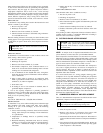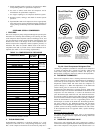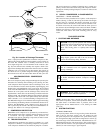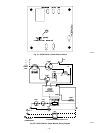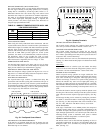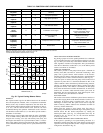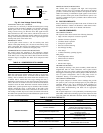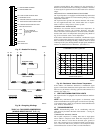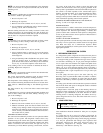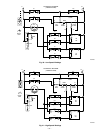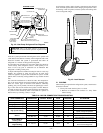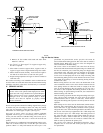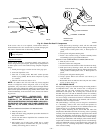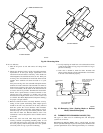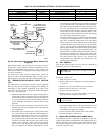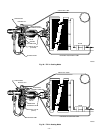
NOTE: To ensure accurate ohm measurements, place ohmmeter
probes on flat surface of compressor-terminal tabs, not the brass
mounting screw.
Open
To determine if a winding has an actual break in the internal wires
and current is unable to pass through:
1. Be sure all power is off.
2. Discharge all capacitors.
3. Remove wires from terminals T1, T2, T3, T7, and T8.
4. Use an ohmmeter on 0-1000 ohm scale to check resistance.
(See Fig. 38, 40, and 41 and Table 18.)
Because winding resistances are usually less than 10 ohm, each
reading will appear to be approximately zero ohm. If during any
check the resistance remains at 1000 ohm, an open or break exists,
and the motor or compressor should be replaced.
Ground
To determine if any wire has broken and come in direct contact
with the housing or shell, causing a direct short to ground:
1. Be sure all power is off.
2. Discharge all capacitors.
3. Remove wires from T1, T2, T3, T7, and T8.
4. Allow crankcase heater to remain on for several hrs before
checking motor to ensure that windings are not saturated
with refrigerant.
5. Using an ohmmeter on R X 10,000 ohm scale, place 1 meter
probe on ″ground″ motor or compressor frame. Make a
good metal-to-metal contact. Place other probe on terminals
T1, T2, T3, T7, and T8 in sequence. Note meter scale.
If any reading of zero or low resistance is obtained, the motor is
grounding. Replace the compressor.
Short
NOTE: This is an extremely critical test and is not advised unless
the following conditions are met.
The correct motor-winding resistances must be known before
testing. See Table 18 for cold-motor winding resistance.
The temperature of the windings must be specified, 70°F±2°F.
The resistance-measuring instrument must have an accurate ohm-
meter (such as a Wheatstone bridge or null balance-type instru-
ment).
The motor must be dry or free from direct contact with liquid
refrigerant.
To determine if any wires have broken through their insulation and
come in direct contact with each other, thereby ″shorting″ all or
part of the winding(s):
1. Be sure all power is off.
2. Discharge all capacitors.
3. Remove wires from terminals T1, T2, T3, T7, and T8.
4. Subtract instrument probe and lead resistance from each
reading. If any reading is within ± 20 percent of the known
resistance from Table 18, the motor probably does not have
a short. Usually a considerable difference will be noted if a
turn-to-turn short is present.
CONTROL BOARD FAILURE
The control board continuously monitors its own operation and the
operation of the system. The diagnostic feature allows easy
troubleshooting of the control and system in the field. If a failure
occurs, the LED light on the control will flash a failure code. If the
failure is internal to the control board, the light will stay on
continuously (no flash). Before replacing control board, reset the
24v power. If the fault clears, check to ensure the indoor and
outdoor unit and electrical service are properly grounded. If the
entire system is grounded, the control board should be replaced, as
the control is not field reparable. If the control-board light is
flashing, see LED and Table 15 for function/malfunction defini-
tion. Cycling 24 vac to control board resets previous error
messages and any lockouts which have occurred. See Table 19 for
more information regarding control-board operation.
CONTROL-BOARD POWER INPUTS AND OUTPUTS
See Fig. 33 and 37 for inputs and outputs.
BLEED RESISTOR
The bleed resistor is a 150k, 2–watt resistor across the compressor-
run capacitor to protect service technician from injury by electrical
shock. Capacitor will bleed-off approximately 1 minute after
power to outdoor unit is turned off. If run capacitor is changed out,
be sure to place bleed resistor on new capacitor. If bleed resistor is
damaged, replace resistor.
START CAPACITOR AND RELAY
The 2-speed system has a second start relay in the control box. One
start relay is for low-speed start, and the second is for high-speed
start. Both start relays use a common-start capacitor. When
servicing this equipment, be certain system starts in both low- and
high-speed operation.
REFRIGERATION SYSTEM
I. REFRIGERATION CYCLE
In a refrigeration system, refrigerant moves heat from one place to
another. It is useful to understand flow of refrigerant in a system.
In a straight cooling system, compressed hot gas leaves compres-
sor and enters condensing coil. As gas passes through condenser
coil, it rejects heat and condenses into liquid. The liquid leaves
condensing unit through liquid line and enters metering device at
indoor coil. As it passes through metering device, it becomes a
gas-liquid mixture. As it passes through indoor coil, it absorbs heat
and refrigerant and is again compressed to a hot gas. The cycle
then repeats.
In a heat pump, the basic cycle is the same. (See Fig. 42.)
Reversing valve in system decides which coil, indoor or outdoor,
becomes evaporator or condenser. It rejects heat into the home
after heat is absorbed by outdoor evaporator coil, thus the home is
heated.
In cooling cycle, the indoor coil becomes the evaporator. It absorbs
heat from the home and rejects it through the outdoor condenser
coil, thus the home is cooled.
A unique feature of the heat pump is that metering devices are
designed to meter refrigerant in one direction of flow and allow
refrigerant to pass unhindered in the other direction. If indoor-
metering device is metering refrigerant, the outdoor device by-
passes refrigerant and vice versa. This allows both coils to serve a
dual function.
II. LEAK DETECTION
CAUTION: Always wear safety glasses and gloves
when handling refrigerants.
New installations should be checked for leaks prior to complete
charging.
If a system has lost all or most of its charge, system must be
pressurized again, up to approximately 150 lb minimum. This can
be done by adding refrigerant using normal charging procedures,
or it may be pressurized with nitrogen (less expensive than
refrigerant). Nitrogen also leaks faster than R-22 and is not
absorbed by refrigeration oil. Nitrogen cannot, however, be
detected by a leak detector. (See Fig. 43.)
—35—



